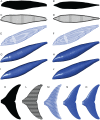Paleomass for R-bracketing body volume of marine vertebrates with 3D models
- PMID: 37641602
- PMCID: PMC10460563
- DOI: 10.7717/peerj.15957
Paleomass for R-bracketing body volume of marine vertebrates with 3D models
Abstract
Body mass is arguably the most important characteristic of an organism, yet it is often not available in biological samples that have been skeletonized, liquid-preserved, or fossilized. The lack of information is especially problematic for fossil species, for which individuals with body mass information are not available anywhere. Multiple methods are available for estimating the body mass of fossil terrestrial vertebrates but those for their marine counterparts are limited. Paleomass is a software tool for estimating the body mass of marine vertebrates from their orthogonal silhouettes through bracketing. It generates a set of two 3D models from these silhouettes, assuming superelliptical body cross-sections with different exponent values. By setting the exponents appropriately, it is possible to bracket the true volume of the animal between those of the two models. The original version phased out together with the language platform it used. A new version is reported here as an open-source package based on the R scripting language. It inherits the underlying principles of the original version but has been completely rewritten with a new architecture. For example, it first produces 3D mesh models of the animal and then measures their volumes and areas with the VCG library, unlike the original version that did not produce a 3D model but instead computed the volume and area segment by segment using parametric equations. The new version also exports 3D models in polygon meshes, allowing later tests by other software. Other improvements include the use of NACA foil sections for hydrofoils such as flippers, and optional interpolation with local regression. The software has a high accuracy, with the mean absolute errors of 1.33% when the silhouettes of the animals are known.
Keywords: Body mass estimation; Body silhouette; Marine vertebrate; R; Software; Superellipse.
© 2023 Motani.
Conflict of interest statement
The author declares that they have no competing interests.
Figures






Similar articles
-
Estimating body volumes and surface areas of animals from cross-sections.PeerJ. 2024 May 28;12:e17479. doi: 10.7717/peerj.17479. eCollection 2024. PeerJ. 2024. PMID: 38827295 Free PMC article.
-
Digital anthropometric volumes: Toward the development and validation of a universal software.Med Phys. 2021 Jul;48(7):3654-3664. doi: 10.1002/mp.14829. Epub 2021 Jul 9. Med Phys. 2021. PMID: 33694162
-
Estimating body segment parameters from three-dimensional human body scans.PLoS One. 2022 Jan 5;17(1):e0262296. doi: 10.1371/journal.pone.0262296. eCollection 2022. PLoS One. 2022. PMID: 34986175 Free PMC article.
-
No bones about it: an enigmatic Devonian fossil reveals a new skeletal framework--a potential role of loss of gene regulation.Semin Cell Dev Biol. 2010 Jun;21(4):414-23. doi: 10.1016/j.semcdb.2009.10.011. Epub 2009 Nov 5. Semin Cell Dev Biol. 2010. PMID: 19896547 Review.
-
Evolutionary dynamics of plants and animals: a comparative approach.Palaios. 1991;6:81-8. Palaios. 1991. PMID: 11538488 Review.
Cited by
-
Estimating body volumes and surface areas of animals from cross-sections.PeerJ. 2024 May 28;12:e17479. doi: 10.7717/peerj.17479. eCollection 2024. PeerJ. 2024. PMID: 38827295 Free PMC article.
-
Reassessment of the possible size, form, weight, cruising speed, and growth parameters of the extinct megatooth shark, Otodus megalodon (Lamniformes: Otodontidae), and new evolutionary insights into its gigantism, life history strategies, ecology, and extinction.Palaeontol Electronica. 2025;28(1):1502. doi: 10.26879/1502. Palaeontol Electronica. 2025. PMID: 40105087 Free PMC article.
-
Downsizing a heavyweight: factors and methods that revise weight estimates of the giant fossil whale Perucetus colossus.PeerJ. 2024 Feb 29;12:e16978. doi: 10.7717/peerj.16978. eCollection 2024. PeerJ. 2024. PMID: 38436015 Free PMC article.
References
-
- Anderson JF, Hall-Martin A, Russell DA. Long-bone circumference and weight in mammals, birds and dinosaurs. Journal of Zoology. 1985;207(1):53–61. doi: 10.1111/j.1469-7998.1985.tb04915.x. - DOI
-
- Barthelmé S, Tschumperlé D. imager: Image Processing Library Based on ‘CImg’. https://cran.r-project.org/web/packages/imager/ 2019
-
- Brassey CA. Body-mass estimation in paleontology: a review of volumetric techniques. The Paleontological Society Papers. 2016;22:133–156. doi: 10.1017/scs.2017.12. - DOI
MeSH terms
LinkOut - more resources
Full Text Sources

